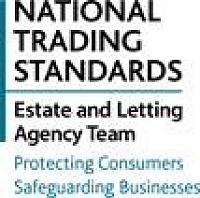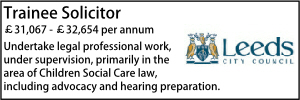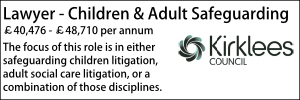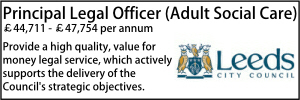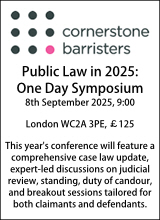
The final say
News
Must read
Families refusing access to support
Features Test
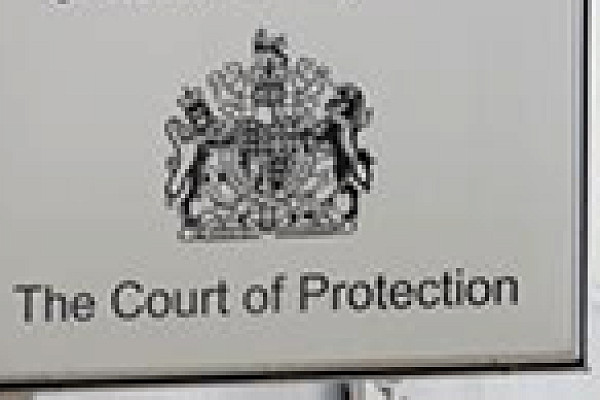
Producing robust capacity assessments and the approaches to assessing capacity

Disability discrimination and proportionality in housing management

Cross-border deprivation of liberty

Dealing with unexplained deaths and inquests

Court of Protection case update: May 2025
Features

Producing robust capacity assessments and the approaches to assessing capacity

Disability discrimination and proportionality in housing management

Cross-border deprivation of liberty

Dealing with unexplained deaths and inquests

Court of Protection case update: May 2025
Sponsored articles
What is the role of the National Trading Standards Estate & Letting Agency Team in assisting enforcement authorities?
Webinars
Is Omeprazole the new EDS?
More features
Provision of same-sex intimate care
Court of Protection case update: April 2025
High Court guidance on Article 3 engagement in care at home cases
‘Stitch’, capacity and complexity
Issuing proceedings in best interests cases
Court of Protection case law update: March 2025
The Health and Social Care (Wales) Bill Series – Regulation and Inspection of Social Care
The Health and Social Care (Wales) Bill Series – Direct Payments for NHS Continuing Healthcare
What is the right approach to Care Act assessments?
Disabled people in immigration bail: the duties of the Home Office and local authorities
Capacity, insight and professional cultures
Court of Protection update: February 2025
Setting care home fees
Could this be the end for local authority-provided residential care?
“On a DoLS”
It’s all about the care plan
Court of Protection case update: January 2025
Mental capacity and expert evidence
Best interests, wishes and feelings
Capacity, sexual relations and public protection – another go-round before the Court of Appeal
Court of Protection Update - December 2024
Fluctuating capacity, the “longitudinal approach” and practical dilemmas
Capacity and civil proceedings
Recovering adult social care charges via insolvency administration orders
Court of Protection case update: October 2024
Communication with protected parties in legal proceedings
The way forward for CQC – something old, something new….
The Ombudsman, DoLS and triaging – asking the impossible?
Outsourcing and the Human Rights Act 1998 – the consequences
Commissioning care and support in Wales: new code of practice
CQC warns councils on social care spending cuts as it issues guidance on care providers registration scheme
- Details
The Care Quality Commission (CQC) has published guidance on the quality and safety standards for its new registration system, warning councils not to allow spending cuts to diminish the quality of adult social care.
The CQC has issued three guidance documents on how providers should comply, including a new judgement framework which the Commission’s inspectors will use to judge compliance with the regulations.
The CQC said that the new registration requirements will be more stringent than before and that exisiting registered providers cannot assume that they will automatically meet the criteria under the new regime.
The scheme will apply to NHS trusts and to local authorities and independent providers from October 2010.
Katherine Bower, chief executive of the CQC, warned councils: "I am deeply concerned about the potential impact of lower spending on social care. We all know there are choppy waters ahead, so the issue is how well the system responds to the situation. We plan to be particularly vigilant about this on behalf of people who use services."
A further key change is that the CQC will give greater weight to the views of people using services in making its judgements. “The guidance focuses on people rather than policies, on outcomes rather than systems,” the CQC stated.
The CQC will have tougher enforcement powers, which include restricting, suspending or removing the care providers' registrations and has promised to use them “to protect people's safety, dignity and rights”.
Councils reluctant to use Forced Marriages Act, says MoJ
- Details
The Ministry of Justice's review of the first year of the Forced Marriages Act of 2007 has found that many councils have been reluctant to use the powers it gives them.
The report, published on 3rd December, also claims that local councils were less aware of the new law than other public services such as the police and the courts.
The 2007 Act enables a number of family courts to make a Forced Marriage Protection Order to prevent a forced marriage from occurring or to protect the victim and help remove them from a situation where a marriage has already taken place.
Forced marriage is not the same as an arranged marriage where both spouses can choose whether or not to accept the arrangement. In a forced marriage, one or both spouses do not, or cannot consent to the marriage and duress is involved. The Act was driven primarily by the impact forced marriage has had on women with Indian and Pakistani descent living in the UK.
The report found that so far there had been 83 applications to make use of the Act since the beginning of implementation of the law in November 2008 and October 2009.
One key issue was the low level of knowledge of the new law, with courts saying they had become aware of few successful efforts within communities to publicise the new law.
The report states successful efforts were mostly limited to London with the message outside the capital made ineffective because people were scared to broach the subject of forced marriages due to “a PC agenda”. The MoJ also said that the police liked the new legislation as it helped them to protect the victim of an enforced marriage.
Councils must improve commissioning of adult social care, says regulator
- Details
Councils must drive up care standards by purchasing from providers more effectively, the Care Quality Commission has said.
The regulator also warned that it would be introducing tougher assessments of local authority performance next year in a bid to hold them to greater account.
In its first major statement on adult social care, the commission said councils – which spend a combined £16.5bn a year in this area – are improving their overall provision of adult social care. Some 95% of local authorities are now commissioning adult social care either “excellently” or “well” – up from 87% the previous year.
The CQC nevertheless has concerns about specific aspects of their performance. One in four councils have only been awarded an “adequate” rating when it comes to giving people choice and control over their care, while a third need to improve in terms of caring for people with dignity and respect.
The report reveals that providers’ ratings are on the up too, with only one in six rated as “poor” or “adequate”. However, this still means that some 3,900 providers fall into these two categories.
“Looking specifically at care homes and agencies, the minimum standards with lowest levels of compliance concern some of the basics of care,” the commission found. “Issues highlighted include planning for individuals’ care, how medication is managed, staff supervision and promotion and protection of people’s health, safety and welfare.”
The CQC said some councils continue to purchase a significant proportion of residential and nursing home care from providers with low ratings. “This raises important questions about whether commissioning is as effective as it could be,” it argued.
Although the commission acknowledged constraints on commissioning (such as limited availability of care provision) and the role of patient choice, it added: “Councils have a responsibility to develop markets over the long-term so that the right care is available.” The regulator plans to hold a dialogue with local authorities on the issue.
Care homes, home care agencies, nursing agencies and shared lives schemes run by councils and voluntary organisations perform better than those in private ownership, the CQC’s research suggested.
Eight councils have meanwhile been identified as “priority improvement councils”, and will be subject to greater scrutiny going on. Another 16 will be subject to in-depth service inspection.
In 2010, the CQC will introduce a new registration system for adult social care providers, NHS providers and independent healthcare. It will also have tougher enforcement powers.
Cynthia Bower, the commission’s chief executive, said: “It is good to see the steady improvements and this should be recognised. [But] there are serious issues for councils to address in areas such as giving people more control over their care, treating people with dignity, and ensuring commissioning is as effective as possible.”
Bower added that she was “deeply concerned” about the possible impact of lower spending on social care, and the prospect of councils raising eligibility criteria as public spending is squeezed.
Council does not have ongoing duty to fund care package forever, Appeal Court rules
- Details
The Court of Appeal has upheld a judgment refusing to allow judicial review proceedings to go ahead against a council’s decision to stop funding a care package.
In R (Manchester City Council) v St Helens Metropolitan Borough Council [2009] WLR (D) 319, the Court of Appeal dismissed an appeal brought by Manchester City Council against Mrs Justice Dobbs’ judgement on 12 December 2008.
The judge had refused to allow Manchester to bring judicial review proceedings against a decision by St Helens to stop funding the care package of PE, a 36-year old individual with a multiple personality disorder who required high-level care. That package was originally funded by St Helens.
After PE moved of her own choice to Manchester in 1999, St Helens carried out an assessment pursuant to section 47 of the National Health Service and Community Care Act 1990 and continued to meet the cost of the care package. However in September 2005, St Helens initiated best interest proceedings in the Family Division. The experts agreed PE should continue with the residential care package, but with responsibility moving from St Helens to Manchester.
Manchester defended attempts to pass responsibility to them and declined to manage the case, arguing that PE was not ordinarily resident in its area. An application under section 32(3) of the National Assistance Act 1948 ensued. The secretary of state decided that PE was ordinarily a resident in Manchester and had been so since April 2000. St Helens consequently stopped the funding.
Queen’s Bench Division President Sir Anthony May accepted St Helens’ submission that they were not under a duty to continue to make arrangements and that Manchester were under the statutory duty under section 29(1) of the National Assistance Act 1948.
The judge held that the exercise of that power did not give rise to an ongoing duty to fund forever. St Helens did not have to establish a change of circumstances in the context of a public law duty. A local authority could withdraw funding subject to considerations of rationality and legitimate expectation.
Lord Justice Scott Baker agreed and Lord Justice Lloyd delivered a concurring judgment.
Equal to the task
- Details
The Equality Bill has wide-ranging implications for local authorities. Lee McBride highlights its key provisions.
The Equality Bill has two key aims:
1.Harmonisation of the various strands of discrimination law; and
2.Strengthening the law on discrimination to support progress on equality.
When does the Bill come into force?
The Bill was introduced into the House of Commons on 24 April 2009, together with a White Paper which set out its aims. Subject to approval of both the Houses of Parliament, the Equality Bill is expected to receive Royal Assent in spring 2010. However, it is worth bearing in mind that a general election must be held by May 2010 and this may impact upon the implementation of the Bill.
So what does the Bill mean for local authorities?
Socio – Economic Duty
The Bill will place local authorities under a new duty to have due regard to “socio-economic inequalities” whenever they make decisions of a strategic nature about how to exercise their functions, including spending and service delivery.
The White Paper explains how the new ‘duty’ will operate in practice by giving the example of a local education authority, which: “could evaluate the schools application process and find that some parents in social housing were having difficulty navigating the system and getting their child a place at school. The authority could then target support at people living on housing estates to help them with the application process”.
The ‘duty’ will not be enforceable by the Equality and Human Rights Commission and nor will individuals be able to claim damages for a failure to comply with this duty.
However, individuals will be able to bring judicial review proceedings against a local authority if they believe that the local authority has failed to consider the socio-economic disadvantage when taking strategic decisions.
Single Public Sector Equality Duty
The Equality Bill will replace the three separate public sector race, gender and disability equality duties with a single unified duty from 2011.
The new unified duty will cover all of the discrimination strands ie disability, gender reassignment, pregnancy and maternity, race, religion or belief, sex, sexual orientation and age (but only in respect of people over 18 years). The new unified duty will not apply to marriage and civil partnership.
A failure by a local authority to have due regard to the unified duty will be enforceable by way of judicial review, as is currently the case. In reality, the commercial imperative to adhere to this duty is likely to be more persuasive in respect of compliance, and in particular in relation to procurement.
Procurement
In the White Paper which accompanied the Bill, the government stated that the Bill will make it clear that public bodies can use procurement to drive equality.
Local authorities should therefore consider introducing standard contract terms requiring their suppliers to comply with equality legislation and, where appropriate, assess this as part of the tender.
For example, contracts for work such as plumbing, carpenters and plasterers – trades in which women are under-represented nationally – could include a condition that the contractor runs a positive action programme to train women in these skills.
Equal Pay
Under the Equal Pay Act 1970, an employer can pay a man more than a woman (or vice versa) for doing equal work, but only if it can prove that the variation in pay is due to a genuine material factor that is not the difference of sex (commonly referred to as the ‘the genuine material factor (GMF) defence’).
Since the Equal Pay Act came into force in 1975, there has been conflicting case law about how the GMF defence can be applied. The government intends to use the Equality Bill to clarify this, with clause 66 of the Bill containing new provisions including a definition of indirect pay discrimination which, unlike direct pay discrimination, can be objectively justified by the employer.
Following the influx of claims brought as a result of the local authority ‘Single Status’ job evaluation scheme, the Bill states that “the long-term objective of reducing inequality between men's and women's terms of work is always to be regarded as a legitimate aim".
Whilst this merely confirms the current case law position, the more controversial issue is whether pay protection is a proportionate means of achieving that legitimate aim where it disproportionately benefits men rather than women.
Equality Reports
To help combat the gender pay gap, the government wishes to promote transparency by requiring large employers to publish information regarding employees’ pay. The government has committed not to use this power before 2013.
However, the position regarding local authorities is different. The government envisages that from April 2011, local authorities with more than 150 employees will be required to report annually on their gender pay gap, ethnic minority employment rate, and disability employment rate.
Summary
It is clear that if the Equality Bill makes it onto the statue book in 2010, it will have a significant impact on local authorities. Local authorities should therefore start making plans for its introduction as soon as possible.
Lee Rogers is an associate at Weightmans LLP
On your guard
- Details
The Safeguarding Vulnerable Groups Act 2006 brought in a new vetting and barring scheme for people working with children and vulnerable adults. It includes volunteers.
The first key milestone was on 12 October 2009. From that date, individuals who are on the barred lists are prevented from undertaking a much broader range of activities. They are barred from any activity which falls within the statutory definition of “Regulated Activity”.
New criminal offences are also created. It is now a criminal offence for A barred individual to seek work, or undertake work with children or vulnerable adults or for an employer to knowingly engage a barred person, whether as a paid employee or as a volunteer.
The Independent Safeguarding Authority (ISA), the new agency created by the Act, will administer the two barring lists which are operational going forward. In place of the POVA, POCA and List 99 barring lists, there will simply be one list for those barred from working with children, and one for those barred from working with vulnerable adults.
A new legal duty has been placed upon all employers whose business involves children or vulnerable adults to give full details to the ISA if someone within their business acts in a way that suggests they should not be working with children or vulnerable adults. Typically an employer will have dismissed this individual following an investigation, and it will need to pass on much of the information generated by that investigation to the ISA.
The next critical date is July 2010. Staff changing jobs or entering this job market will be able to (but not required to) register from that date. However, registration for those workers will become mandatory from November 2010 and from that date there will be tough penalties for those employers who fail in their responsibility to carry out the necessary checks or recruit people who are not ISA-registered. Employers who knowingly permit a barred individual to engage in regulated activity face a maximum penalty of up to six months in prison plus a fine.
It is expected that all employees and volunteers working in this sector, even those who do not move to a new employer, will be registered by 2015 and this process will start in 2011.
Improved scheme
There are currently two overlapping lists of people who are barred from working with children, and a third list relating to the social care of adults. This is a recipe for confusion. Furthermore the current Criminal Records Bureau (CRB) check is simply a snapshot; frozen in time. If the check is carried out on a Monday, and the individual is convicted of an offence on the Tuesday, the CRB check will not pick that up.
There will be one barring list relating to children, and another for vulnerable adults. Importantly, the new system will be able to react to new information, and so someone initially cleared to work with children or vulnerable adults can be subsequently barred.
The ISA will assess the information to hand about an individual including the results of the CRB check, and decide whether that person should be barred.
Types of activity
The Act identifies two types of activity – regulated activity or controlled activity.
The precise definition of regulated activity is complex but it includes any position which involves providing education training, care, assistance, therapy and the provision of transport for children and vulnerable adults. It also includes any position that involves the management of people carrying out these functions.
Controlled activity tends not to involve direct contact with children or vulnerable adults, but may involve access to information about them.
The barring provisions provided for in the Act relate to regulated activity – if the ISA bars an individual they may not engage in regulated activity. They can still be involved in controlled activity, provided safeguards are in place.
Scheme operation
Under the new system, an individual who wishes to work with children or vulnerable adults will need to apply for a check. The application will require proof of identity and a fee. It is hoped that where there is no information on an individual (the position on 90% of applications) the results will come through within one week. Otherwise, the check will take longer.
CRB will gather information about the individual. Occasionally there will be information that needs to be passed to the ISA for consideration before deciding whether to include the applicant on the barred list. Even more occasionally the information shows an individual has been convicted a specified offence which leads to an automatic ban. A barred individual will have the right to make representations.
Whether the ISA decide an individual is barred or not barred, both the individual and their employer are told.
Once a person applies for a check an ISA file is opened on them. Throughout their career, the ISA may receive information about that individual from a variety of sources such as the police, local authorities, employers, professional bodies or Inspectorates. Whenever such new information is received, the ISA will then consider whether it should lead to a decision to bar, with representations being sought when appropriate.
It is hoped that as soon as there is evidence that an individual has behaved inappropriately towards children or vulnerable adults, that information will be passed to the ISA, who will give it due consideration and, where appropriate, bar the individual.
Notifications that someone has been barred are likely to come out of the blue. A children’s home may receive a phone call from the ISA saying that a particular staff member has been barred, and the home will then need to take immediate action to remove that individual, as it is a criminal offence to allow that person to continue in regulated activity. It is likely that the individual will have to be dismissed summarily.
Online checks
Under the new scheme there is the ability to make online checks on an individual. This will tell you instantaneously whether an individual is barred, or is cleared to work. It will be similar to the current standard level CRB check.
For recruitment into almost every regulated activity role, however, the potential employer will need information equivalent to an enhanced CRB check, and this will only be available through an application, rather than online.
New criminal offence
The Act creates several criminal offences for non-compliance. Employers commit offences if they engage an individual in regulated activity that is either barred or not subject to monitoring. This offence is committed by both the organisation, and by any manager who is either complicit or reckless.
It is an offence for an individual to seek controlled activity if he has not been checked, and it is also an offence to engage such an individual.
Sarah Erwin-Jones is a partner in the social care team at Browne Jacobson
Page 135 of 270








